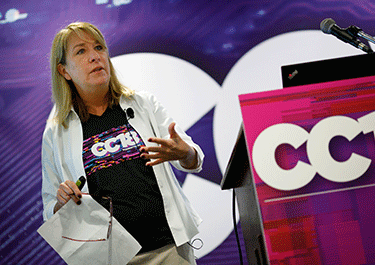 Operations efficiency may not be the coolest topic when thinking about your technology business, but it is key to maximizing your profitability, as we learned in a session titled Operational Efficiency: Going Beyond Just Good Processes at CompTIA ChannelCon 2018 this month at Marriott Wardham Park in Washington, D.C.
Operations efficiency may not be the coolest topic when thinking about your technology business, but it is key to maximizing your profitability, as we learned in a session titled Operational Efficiency: Going Beyond Just Good Processes at CompTIA ChannelCon 2018 this month at Marriott Wardham Park in Washington, D.C.
According to CompTIA Senior Director Carolyn April, only 19 percent of companies surveyed for the association’s recent Operational Efficiency in The Channel report say they’re very efficient at running their businesses smoothly. Respondents reported they want to improve operational efficiency just as much as they want to get better at reaching new customers.
Businesses continue to transform and those experiencing the highest levels of transformation have doubled in the last four years. As they transform, operations and process improvement have become more important than ever. With an increasing amount of data to manage, as well as the need to move into new business lines, it’s easy to see why operations are becoming harder.
On top of that, customer engagements are more complex than ever before. “You need to be flexible and be able to manage change,” said panelist MJ Shoer, director of client engagement and vCIO at OnePath.
Having documentation is key to efficiency as well. “Policies and procedures are key,” said panelist Vince Tinnirello, CEO of Anchor Network Solutions.
Much of the discussion was around how to define operational efficiency. One panelist, Paul Cronin, facilitator of excellence at Cronin Corporation, broke it down to, “How can I do the most, with the least? How many projects can I handle with the number of people that I currently have?” For him, efficiency “starts with cultural leadership, focusing on the lean and the small changes you can make.”
Another theme of discussion among the panelists as well as audience members was around training employees to understand why operations are so important. Creating efficient employees versus finding already efficient employees was something of a debate. While hiring outside people that excel in process-based workload might be better, it sometimes comes at a greater expense than training current or lower level employees to be more efficient. “As companies are absorbed and acquired, you need to use the talents of all the best people within both the parent company and those that were acquired,” Shoer said.
Getting people to use new processes and procedures is also part of the challenge. Tinnirello uses specific KPIs to determine not only who is performing, but when you need to hire for specific roles within his organization. He said, “Find a framework to when to hire and join a peer-group.”
Shoer agreed on the use of KPIs. “Keep it clear and keep everyone accountable,” he said.
Cronin echoed all this. “Inefficient companies have too many goals,” he said. “Keep it easy for everyone to understand.”
Panelist and CompTIA Advisory Council Member Ryan Walsh, CEO of Pax8, reminded audience members to seek help from their partners. “Vendors and distributors can help with operational efficiency,” he said. “They can help streamline billing [and] deployment and in many other ways.” Tinnirello mentioned how distribution has helped remove friction from his processes.
Toward the end of the session, an audience member, Dan Shapiro of TeamLogic IT, who sits on the CompTIA Board Of Directors, asked the panel, “What are three of your metrics or goals?” While each of the four panelists had some kind of revenue and margin goals, all had customer satisfaction as a key piece of the puzzle. Paul described it as having the “ultimate client experience.”
You can download the CompTIA research report Operational Efficiency In The Channel here.

 Add CompTIA to your favorite RSS reader
Add CompTIA to your favorite RSS reader

